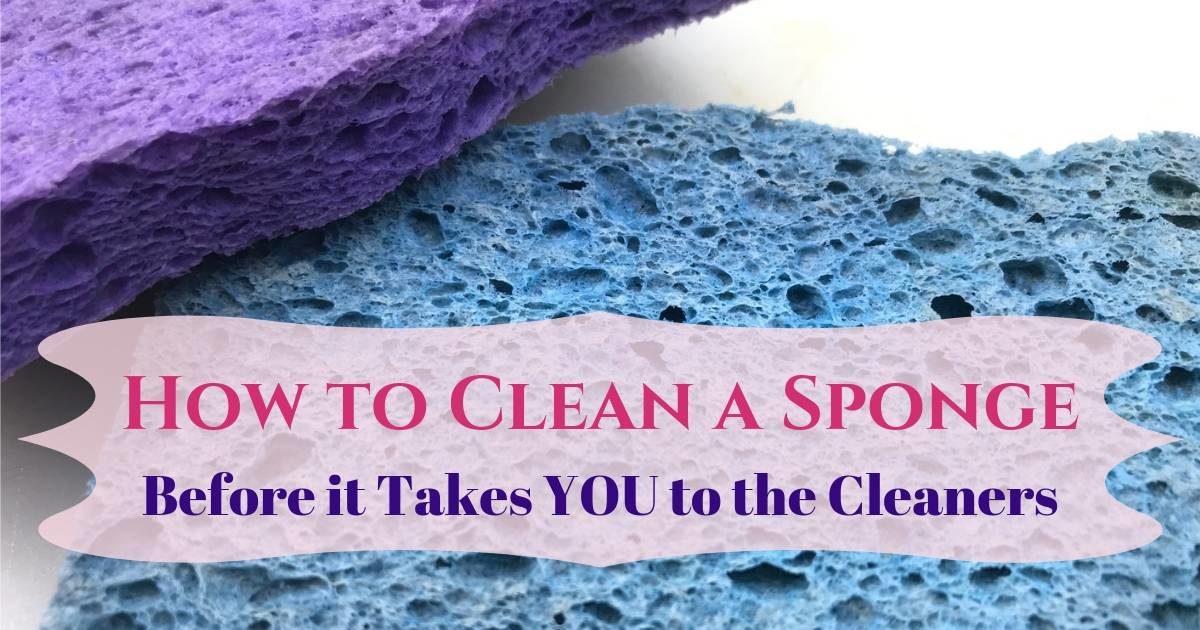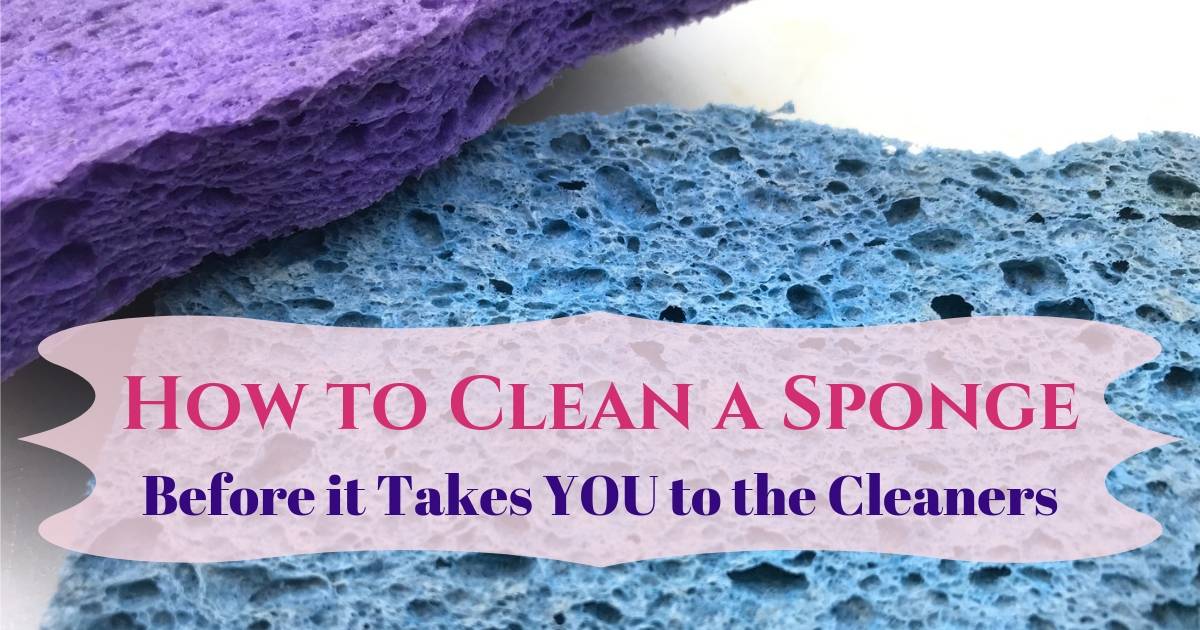There’s something I think you should know about that helpful little kitchen sponge that seems to make dishwashing a breeze. It’s so overrun by smelly bacteria that it’s an absolute miracle you and your family aren’t in a constant state of illness. This is why it’s important for you to know how to clean a sponge properly—before it takes YOU to the cleaners!
What several studies have shown is that, aside from the shower curtain, TV remote, and cellphone, your kitchen sponge is one of the filthiest things in your home.
For quite some time now, people have known how dirty and stinky sponges can get. Many of us clean them to the best of our knowledge or we just toss them when they’re discolored or smelly and we simply reach for a new one.
For the most part, this seems to be working—at least that’s what our own anecdotal evidence suggests. But what are the experts seeing?
The Down and Dirty About Your Sponge
There’s been a lot of talk lately about a recent study involving the examination of kitchen sponges and their potential for bacterial growth. Interpreters of this study came to the conclusion that it does no good to clean a sponge yourself.
Traditional DIY sponge-cleaning methods only proliferate the growth of harmful bacteria because they kill off the safer bacteria that would normally keep the pathogenic type in check.

The problem with this claim is that the study only covered 14 sponges—none of which presented the pathogenic bacteria experts are concerned about, such as salmonella, E. coli, and staphylococcus.
These 14 sponges were all centralized in a region whose hygienic practices and a diet heavy-laden with meat is not always comparable to other regions and cultures.
In essence, the targets studied are far too isolated to represent the world’s kitchen sponge concerns as a whole.
Could it be possible that many kitchen sponges do carry those types of pathogens? Oh, most certainly! But, it also depends on how the sponges are used.
It they’re used to clean up the messes from raw meat or fish, the potential for such growth is higher. If they’re only used on the dishware used to cook or eat the meat or fish, then the chances are very slim.
Another possibility is that a sponge is cross-contaminated if it’s used to clean other parts of the house in addition to dishes. Yet, in the vast majority of homes across the globe, most people do not cross-contaminate their kitchen sponges.
Most households have specific cleaning rags and sponges for specific purposes, and they are kept separate from one another.
So, should you be concerned about deadly pathogens growing on your kitchen sponges? Yes! But, should you be panicking and changing everything about the way you wash your dishes? No!
As long as you understand what messes are best for sponges, how to clean a sponge properly, and when to toss a sponge and buy a new one, you can safely continue using sponges in the kitchen.
What Messes are Best for Sponges?
Kitchen sponges can safely be used on most messy dishes. When it comes to caked-on food, oily messes, and raw meat and fish, it is best to first use a paper towel and remove as much of the mess as you can.
If you’re cleaning a cutting board and knife used for meat and fish, do not use a sponge. First, wipe off the items with a paper towel. Throw away the used paper towel.
Use a kettle to bring some water to a high boil, then pour it generously over the cutting board and knife. (Feel free to repeat this step twice.)
Afterward, soak the items in water and white distilled vinegar, or simply pour white vinegar over them before using the kitchen sponge and hot, soapy water to complete the clean-up.
If you’re cleaning a pot or pan that has set out for a while, consider boiling water in it on the stove first so that the food, oil, or meat residue can be broken up by the heat and easily removed afterward by a paper towel.
Even if there is still a slight oil residue remaining, a sponge can now be used to finish the job—as long as it is sanitized afterward.
How to Clean a Sponge Properly
The “How to Clean Sponges with Bleach” Method
Don’t. Bleach only affects weak bacteria. It will make sponges look clean and smell “fresh,” but it’s not your greatest ally when it comes to disinfecting sponges.
The “How to Clean a Smelly Sponge” Method
Don’t. If a sponge is already smelling, it means that several bacterial colonies are present and have reached maturity. The sponge needs to go. It’s not worth the $1–$4 you’d be saving. Toss it and buy a new one.
The “Sponge in Dishwasher” Method
Don’t. The dishwasher may emit scalding-hot water, but sponges are so porous and cavernous that it is highly unlikely that the water spray will effectively reach every nook and cranny of the sponge.
The “How to Disinfect a Sponge in Boiling Water” Method
This is most effective if you drop the sponge in boiling water or set it in a bowl filled with freshly-boiled water. Leave it for well over a minute. Don’t just pour boiling water over it in the sink and think that’s all it’s going to take.
Some of the scariest pathogenic bacteria will survive a few seconds of heat, but if the sponge is fully immersed in boiling/freshly-boiled water for over a minute, the bacteria won’t have much of a chance.
The “How to Clean a Sponge with Vinegar” Method
I like this method. Bacteria—and even mold and yeast—are rarely a match for vinegar. Vinegar—even when rinsed well—also leaves a residue that continues to battle the potential growth of microbes for several hours after the initial immersion.
You can do full-vinegar or do a 1/2 water, 1/2 distilled white vinegar ratio and just let the sponge sit in it for a few minutes. Every once and awhile, squeeze the sponge while it’s immersed in the vinegar—to allow the vinegar to reach every pore and crevice. Then rinse and squeeze out.
If you don’t mind a strong vinegar scent, then don’t rinse it off—just squeeze out the liquid and set the sponge out to dry.
The “Sponge in Microwave” Method
This will only be effective if you’ve thoroughly rinsed the sponge—maybe even in vinegar—and if you make sure it’s damp before you put it in the microwave. (Oily residue on sponges will make this a useless method.)
Microwave on high for 1 minute. You will hear sizzling and maybe even pick up a weird “burnt” smell, but everything’s perfectly fine. The sponge will be extremely hot, so be careful when you remove it.
How to Keep Sponges Fresh at All Times
Firstly, be sure you’re using your sponges on the right kitchen messes and that you’re not cross-contaminating them with other household chores and raw meats and fish (as we discussed earlier).
Lastly, commit yourself to preventative measures. There’s no good reason why you should ever put yourself or your family at risk simply because you don’t feel like giving your sponge a little TLC.
It only takes a few extra moments of your time after you’re done with the dishes to ensure that you’re not encouraging bacterial growth.
Fresh Sponge Rule #1
Always, always, always rinse out your sponge with hot water, making sure there are absolutely no food particles, dish soap, or an oily feeling.
Fresh Sponge Rule #2
Always, always, always squeeze out your sponge until there are absolutely no drips left.
Fresh Sponge Rule #3
Always always, always set your squeezed-out sponge out to dry on its scratchy side (not on its soft side) and be sure the surface you set it on is clean and free of water.
Fresh Sponge Rule #4
The boiling water, white vinegar, and microwave methods do work. Pick one and use it after the dishes are done each day.
Unless some dishes from breakfast and lunch were particularly nasty or oily, you only need to do one of these methods once a day—generally before bedtime.
Just be sure that, for the earlier part of the day, you follow rules 1–3.
Fresh Sponge Rule #5
Always, always, always replace your sponge once a week. Pick a day, discard, and enjoy the freshness of a new sponge for 6 days.
Fresh Sponge Rule #6
Don’t use a sponge! In the end, sponges are nearly impossible to clean once food particles and other contaminants get into the pores.
This reason alone makes it imperative to never use them on clean or sanitized surfaces with the better alternatives of using dishcloths or disposable, single-use sponges or dishcloths.
Final Thoughts on Sponge Cleanliness
Most of us home chefs aren’t in the habit of always practicing safe sponge hygiene, which is why—after reading that study—I decided I better say something.
Basically, I just want you to stay safe and healthy. If all it takes is a little awareness and a willingness to take our sponge-sanitation just one step further, then I think we can do that, don’t you?
Please consider sharing this with other moms you know who use sponges.
Also, if you have any unique sponge-cleaning suggestions or you know of a specific brand or type of sponge that is resistant to pathogenic microbial growth, please share in the comments below!
I look forward to reading your thoughts on this.

